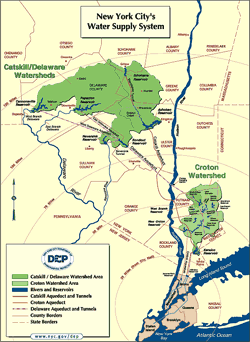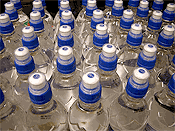Watershed Protection & New York City's Water Supply
by Elana Mass
Supplying drinking water to New York City is a tall order.
Approximately 1.4 billion gallons of water are consumed daily by eight million New York City residents and one million upstate customers. At present, all of New York City's drinking water is unfiltered. Although approximately ten percent of the supply, coming from the east-of-Hudson reservoirs, will begin filtration in 2012, the vast majority will remain unfiltered.
How does New York City keep its water supply clean and protected, especially in the face of increasing development pressures in the watershed?
 New York City 's drinking water supply system consists of 19 reservoirs and 3 controlled lakes within a 1,972 square mile watershed that stretches north and west of the City. New York City 's drinking water supply system consists of 19 reservoirs and 3 controlled lakes within a 1,972 square mile watershed that stretches north and west of the City.
The watershed has two subregions:
2. The Catskill/Delaware system to the west, which supplies 90%.
All watershed lands are subject to the Watershed Rules and Regulations (officially known as the Rules and Regulations for the Protection from Contamination, Degradation, and Pollution of the New York City Water Supply), which govern activities that could degrade water supply such as sewer collection, stormwater discharges, and impervious surfaces.
Before entering City pipes, all drinking water is treated with chlorine, fluoride, food-grade phosphoric acid, and sometimes with sodium hydroxide. Water quality and infrastructure are overseen by the City's Department of Environmental Protection (DEP) in coordination with the EPA and New York State 's Department of Health.
An Ounce of Protection v. a Pound of Cure
In the densely developed Croton watershed, which contains extensive NYC suburbs, development pressures and the high cost of land have limited the DEP's ability to undertake protection mechanisms such as land acquisition (although land acquisition is used as an secondary layer of protection).
As a result, although water from this system currently meets health standards, the City is constructing a filtration plant, to be completed by 2012, that will correct aesthetic issues with color, taste and odor (that primarily occur in the summer) and to ensure the Croton supply's continued compliance with surface water regulations.
By contrast, the Catskill/Delaware system, covering 1,600 miles, remains unfiltered, making it the largest unfiltered water supply in the US. Maintaining quality standards for such a large water supply without filtration is a tremendous challenge that requires millions of dollars each year on outreach and education, land management, land acquisition, and partnerships with watershed non-profits and municipalities.
Given the time and energy devoted to developing and managing these programs, it might seem that a combination of filtration and disinfection would be a simpler way to achieve standards. Yet, the DEP has concluded that filtration and disinfection are insufficient without preemptive watershed protections.
To begin with are the costs involved: the construction cost for a filtration plant large enough to support the Catskill/Delaware system is estimated to be $6 - $10 billion dollars, with an additional $110 million annually in operation and maintenance.
By contrast, although the total cost of watershed programs are difficult to quantify, it is not more than $100 million a year. In addition are the health and safety issues that would arise: without preemptive land protections, significantly higher levels of disinfecting chemicals would need to be used to purify the water. By-products from these chemicals are known to pose serious health risks and their use is in fact limited by federal law. Finally, high levels of chlorine are believed to damage the fittings within the water delivery system.
For all these reasons, it is preferable to protect the drinking water at its source.
New York City's water supply protection programs rely on both regulatory and voluntary actions.
The DEP uses an innovative combination of regulation and voluntary programs and partnerships to protect the Catskill/Delaware watershed. Regulation alone cannot guarantee that water quality criteria will be met: with more than 70% of the Catskill/Delaware lands under private ownership (for residential, commercial, and agricultural uses), activities can only be constrained to a limited extent before regulatory takings issues arise.
The voluntary programs allow the DEP to work with watershed communities to meet quality criteria while enabling economic and productive use of land by landowners.
The watershed programs fall into three main categories:
-
Land Acquisition Program (LAP)
Purchases are undertaken selectively, with properties prioritized for purchase based on the presence of key natural features such as streams and wetlands, proximity of land to reservoirs, and potential for development. Land is only purchased from willing sellers, and at fair market prices. Since 1997, the City has acquired or contracted easements for approximately 70,000 acres of land at a cost of $168 million. Prior to purchasing the land, the City consults with the municipality to ensure the community's interests are taken into account. Watershed communities are able to exempt certain areas from solicitation under the LAP.
-
Land Management
The DEP has numerous programs designed to encourage private landholders to protect watershed lands. These programs are operated in concert with watershed municipalities and non-profit partners, including the Watershed Agricultural Council (WAC) and the Catskill Watershed Corporation (CWC). Management programs include Stream Management, Wetlands Protection, the Watershed Forestry Program, Waterfowl Management, public outreach and education, and agricultural pollution prevention plans.
-
Capital Programs
On its own or with its partners, DEP undertakes numerous capital projects in the Catskill/Delaware watershed designed to preserve and improve water quality. These include:
Wastewater Treatment Plants (WWTP) Upgrades.
At its own cost, the City has upgraded and operates over 100 non-city treatment plants to ensure the highest degree of wastewater treatment; the DEP has also funded the construction of new WWTPs or septic systems were existing systems were failing.
Septic System Rehabilitation and Replacement.
In partnership with the CWC, the City has fixed over 2,000 failing septic systems in the watershed and helps cover the cost of pump-outs, maintenance, and inspections of single- and two-family septic systems.
Stormwater Retrofit Program.
Jointly administered by the DEP and the CWC, the program encompasses stormwater infrastructure assessments, maintenance, planning, and capital expenditures.
Sewer Extension Program.
Working with watershed municipalities, the DEP has extended sanitary sewers where systems were failing or likely to fail.
How to Measure Success
 It should be noted that the water supply's unfiltered status is not a given: the DEP must regularly submit proof to the EPA that the water meets a set of filtration avoidance criteria. The criteria include quality standards for coliforms, turbidity, and disinfection by-products; operational criteria requiring that pathogens (like Giardia and viruses) be deactivated with a minimum of chlorine residual in the system; and watershed control criteria to minimize potential contamination of source waters. It should be noted that the water supply's unfiltered status is not a given: the DEP must regularly submit proof to the EPA that the water meets a set of filtration avoidance criteria. The criteria include quality standards for coliforms, turbidity, and disinfection by-products; operational criteria requiring that pathogens (like Giardia and viruses) be deactivated with a minimum of chlorine residual in the system; and watershed control criteria to minimize potential contamination of source waters.
To date, the EPA has issued a Filtration Avoidance Determination (FAD) allowing the water to remain unfiltered provided that certain milestones are met over time to ensure that water quality is maintained.
Through the programs and partnerships described above, NYC's drinking water has maintained its reputation as one of the finest supplies in the United States. The innovative combination of watershed programs and partnerships limits the need for filtration and disinfection, and supports the adage “an ounce of prevention is worth a pound of cure.”
Elana Mass is happy to be “virtually” volunteering for PWCA from her computer in Brooklyn, NY. When not trying to understand convoluted regulations, Elana enjoys hiking, playing the piano, and exploring the world with her two-year old. Elana has a B.A. in Political Science from Tufts University and a Masters of Urban Planning from New York University. She was a senior planner specializing in comprehensive and environmental planning with Buckhurst, Fish, & Jacquemart, a Manhattan-based planning firm, before leaving in 2004 to be home with her child. |